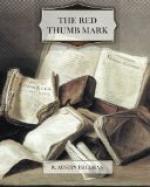“Yes, that is so; but I still do not see why the fellow should not have thrown away this label and typed another.”
“Look at the slip again,” said Thorndyke. “It is faintly but evenly discoloured and, to me, has the appearance of having been soaked in water. Let us, for the moment, assume that it has been. That would look as if it had been removed from some other package, which again would suggest that the person using it had only the one slip, which he had soaked off the original package, dried, cut down and pasted on the present label. If he pasted it on before typing the address—which he would most probably have done—he might well be unwilling to risk destroying it by soaking it a second time.”
“You think, then, there is a suspicion that the package may have been tampered with?”
“There is no need to jump to conclusions,” replied Thorndyke. “I merely gave this case as an instance showing that careful examination of the outside of a package or letter may lead us to bestow a little extra attention on the contents. Now let us open it and see what those contents are.”
With a sharp knife he divided the outside cover, revealing a stout cardboard box wrapped in a number of advertisement sheets. The box, when the lid was raised, was seen to contain a single cigar—a large cheroot—packed in cotton wool.
“A ‘Trichy,’ by Jove!” I exclaimed. “Your own special fancy, Thorndyke.”
“Yes; and another anomaly, at once, you see, which might have escaped our notice if we had not been on the qui vive.”
“As a matter of fact, I don’t see,” said I. “You will think me an awful blockhead, but I don’t perceive anything singular in a cigar manufacturer sending a sample cigar.”
“You read the label, I think?” replied Thorndyke. “However, let us look at one of these leaflets and see what they say. Ah! here we are: ’Messrs. Bartlett and Sons, who own extensive plantations on the island of Cuba, manufacture their cigars exclusively from selected leaves grown by themselves.’ They would hardly make a Trichinopoly cheroot from leaf grown in the West Indies, so we have here a striking anomaly of an East Indian cigar sent to us by a West Indian grower.”
“And what do you infer from that?”
“Principally that this cigar—which, by the way, is an uncommonly fine specimen and which I would not smoke for ten thousand pounds—is deserving of very attentive examination.” He produced from his pocket a powerful doublet lens, with the aid of which he examined every part of the surface of the cigar, and finally, both ends. “Look at the small end,” he said, handing me the cigar and the lens, “and tell me if you notice anything.”
I focussed the lens on the flush-cut surface of closely-rolled leaf, and explored every part of it minutely.
“It seems to me,” I said, “that the leaf is opened slightly in the centre, as if a fine wire had been passed up it.”




